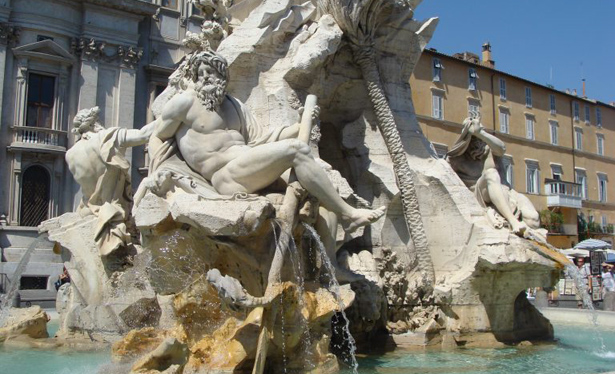
The Fontana dei Quattro Fiumi by Bernini
Built for pope Innocent X Pamphilj, this magnificent fountain in the centre of Piazza Navona was unveiled in 1651. The pope’s coat of arms, the dove and the olive branch, decorate the pyramid rock formation supporting the Roman obelisk, which once stood in the Circus of Maxentius on the appian Way. Bernini designed the fountain, which was paid for by means of taxes on bread and other staples.
The great rivers – the Ganges, the Danube, the Nile and the River Plate – are represented by four giants. The Nile’s veiled head symbolizes the river’s unknown source, but there is also a legend that the veil the conveys Bernini’s dislike for the nearby Sant’Agnese in Agone, designed by his rival Borromini. Similarly, the athletic figure of the River Plate, cringing with arm upraised, is supposed to express Bernini’s fear that the church will collapse. Sadly, these widely believed stories can have no basis in fact: Bernini had completed the fountain before Borromini started work on the church.
Piazza Navona in Rome
Rome’s most beautiful Baroque piazza follows the shape of Domitian’s Stadium which once stood on this site – some of its arches are still visible below the church of Sant’Agnese in Agone. The agones were athletic contests held in the 1st-century stadium, which could seat 33,000 people. The word “Navona” is thought to be a corruption of in agone. The piazza’s appearance and atmosphere were created in the 17th century with the addition of the Fontana dei Quattro Fiumi. The other fountains date from the previous century but have been altered several times since. The basin of the Fontana di Nettuno, at the northern end, was built by Giacomo della Porta in 1576, while the statues of Neptune and the Nereids date from the 19th century. The Fontana del Moro, at the southern end, was also designed by della Porta, though Bernini altered it later, adding a statue of a Moor fighting a dolphin. Up until the 19th century, Piazza Navona was flooded during August by stopping the fountain outlets. The rich would splash around in carriages, while street urchins paddled after them. Today, with its numerous shops and cafés, the piazza is a favourite in all seasons. In summer it is busy with street entertainers, while in winter it fills with colourful stalls selling toys and sweets for the feast of the Befana.









